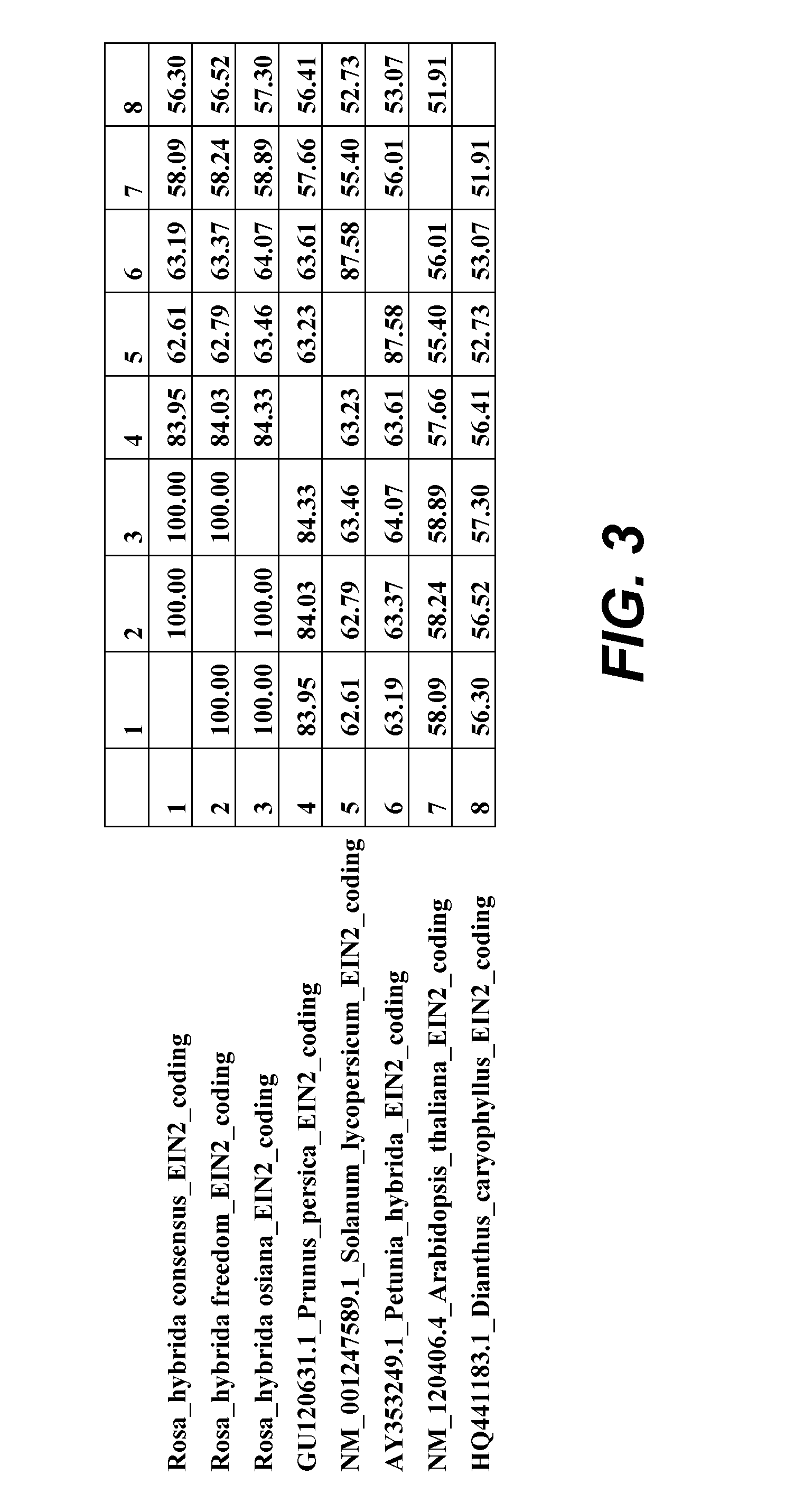Compositions and Methods for Delaying Senescence in Cut Flower
a technology of senescence and cut flowers, applied in the field of compositions and methods for delaying senescence in cut flowers, can solve the problems of silver being a heavy metal, affecting the senescence rate, so as to achieve the effect of reducing senescence rate, delaying senescence, and suppressing ac3s expression
- Summary
- Abstract
- Description
- Claims
- Application Information
AI Technical Summary
Benefits of technology
Problems solved by technology
Method used
Image
Examples
example 1
Polynucleotide Treatment of Carnation Flowers with Triggers Homologous to the EIN2 Gene
[0107]Polynucleotide triggers (0.5-2 nmol) homologous to the carnation EIN2 gene were prepared in 0.01% Silwet L-77 in a total volume of 1 mL. Flowers stems were cut to 25 cm under dH20 and then transferred to 15 ml conical polypropylene tubes containing the trigger-Silwet solution (Day 0). After approximately 75% uptake of the trigger solution, an additional 1 mL of H20 was added to each tube and again allowed to be absorbed. Each tube was then filled to the 15 mL mark and allowed to stand overnight in a 25 C growth chamber with 16 h light. Treatments were randomized in the racks.
[0108]On the following day (Day 1), the flowers were transferred to new tubes, arrayed in identical order, containing 12 mL dH20. Between Day 1 and Day 4 tubes were monitored for signs of senescence and refilled with dH2O and 100 mg / L 8-Hydroxyquinoline sulfate (8-HQS) as needed. From Day 4 until the termination of the e...
example 2
Polynucleotide Treatment of Rose Flowers with Triggers Homologous to the EIN2 Gene
[0113]Polynucleotide triggers (0.5-2 nmol) homologous to the rose EIN2 gene are prepared in 0.01% Silwet L-77 in a total volume of 1 mL. Rose flowers are obtained from a commercial grower where stems are harvested and shipped under normal commercial handling for each variety, most commonly at the tight-bud stage. Flowers typically arrive 4-5 days postharvest at which time flower stems are cut to 25 cm under diH20 and then transferred to 15 ml conical polypropylene tubes containing the trigger-Silwet solution. After approximately 75% uptake of the trigger solution, an additional 1 mL of diH20 is added to each tube and is allowed to be taken up. Each tube is then filled to the 15 mL mark with diH2O and allowed to stand overnight in a 25 C growth chamber with 16 h light. Treatments are randomized in the racks. On the following day, the flowers are dipped in diH20 to wash off residual trigger solution and ...
example 3
Identification of Rose Ethylene Signaling and Biosynthetic Pathway Sequences
[0120]This example describes non-limiting embodiments of methods for identifying rose ethylene signaling and biosynthetic pathway coding sequences, useful in engineering polynucleotides which prevent or reduce rose senescence.
[0121]Rose cDNA orthologs to the known sequences of Arabidopsis thaliana ethylene signaling and biosynthetic pathway genes (EIN2, EIN3, ACC synthase (ACS), ACC oxidase (ACO)) were identified using Tblastx. Arabidopsis nucleotide sequences for EIN2, EIN3, ACS, and ACO were compared (e value E-05) to a unigene library for the Rosa hybrid, osiana and orthologous sequences were identified. The orthologous sequences identified in this analysis were confirmed by performing a reciprocal Blast against Arabidopsis thaliana (TAR 9.0). Table 8 shows the result of this analysis.
TABLE 8Rose cDNA orthologs to known Arabidopsis thaliana ethylene signalingand biosynthetic genes.SEQ ID NOSequence_IDAnno...
PUM
| Property | Measurement | Unit |
|---|---|---|
| concentration | aaaaa | aaaaa |
| concentration | aaaaa | aaaaa |
| concentration | aaaaa | aaaaa |
Abstract
Description
Claims
Application Information
 Login to View More
Login to View More - R&D
- Intellectual Property
- Life Sciences
- Materials
- Tech Scout
- Unparalleled Data Quality
- Higher Quality Content
- 60% Fewer Hallucinations
Browse by: Latest US Patents, China's latest patents, Technical Efficacy Thesaurus, Application Domain, Technology Topic, Popular Technical Reports.
© 2025 PatSnap. All rights reserved.Legal|Privacy policy|Modern Slavery Act Transparency Statement|Sitemap|About US| Contact US: help@patsnap.com



